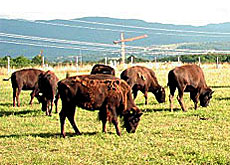Swiss Wild West far from lawless

Far from the rolling prairies of the American Midwest, bison are becoming a familiar sight in western Switzerland.
But Switzerland’s growing numbers of bison farmers are finding to their frustration that, unlike the Wild West, their country is not a lawless land.
There are now eight farmers in Switzerland raising these North American buffalo.
The pioneer was Laurent Girardet from Geneva, who imported the first ten females from Canada in 1989.
If it seemed something of a gamble back then, it has paid off handsomely, with consumers increasingly looking for alternatives to meat from intensively reared animals.
Girardet’s bison have become something of a landmark for those travelling regularly from Lausanne to Geneva.
The herd of 150 animals, the largest in Switzerland, can often be seen grazing in fields alongside the motorway near the commune of Colovrex.
Bovine or not?
But these are not traditional farm animals, since the bison cannot be domesticated.
A mature male North American bison can weigh as much as one ton. They are generally peaceful creatures – except during the rutting season – but, even so, Laurent Girardet never enters their enclosures on foot.
Under Swiss legislation, any bison reared in Switzerland is classed as a wild animal – until it dies, that is. Then, it is the legislation on domesticated bovine meat that applies.
For this reason, bison farmers have been affected by the stringent regulations put in place to deal with mad cow disease, or bovine spongiform encephalopathy (BSE).
Bison, like domestic cattle, are ruminants and can in theory catch BSE, but none has ever been known to, since they do not consume animal by-products.
“We can guarantee that our bison eat only grass, hay and cereals produced on the farm. No one in Switzerland feeds their bison ‘concentrate’,” Girardet told swissinfo.
Currently, Girardet is prevented from importing any new animals into Switzerland, since these too are considered to be bovine, under the law: “We desperately need them to inject new blood into our herds,” he says, pointing out that the other bison in Switzerland came originally from Colovrex.
“We work within completely different parameters to dairy farmers,” Girardet says. “We absolutely have to have a special status for bison, whether for imported meat or live animals, just as we have for sheep or horses.”
Healthy alternative
Bison meat is tasty and very healthy, being rich in protein but low in fat and cholesterol.
It’s flavour is like beef, if a little more “gamey”, and its texture is much more tender. It also produces excellent air-dried and smoked meat.
“We can’t keep up with demand,” Girardet says. “Interest has really increased since BSE.”
It is ironic, then, that having been regarded by consumers as a safe alternative to intensively reared cattle, bison meat is now subject to the same constraints as beef.
Unlike the buffalo reared in North America, Swiss bison are guaranteed not to have been fed hormones or antibiotics. Whereas a Canadian or American bison might be slaughtered when it is 18 months old, the Swiss animals are killed a year later.
Currently, only 30 male bison are slaughtered each year, as Girardet seeks to build up his herd.
To minimise stress associated with transporting them to the abattoir, they are shot in their paddocks.
Diversification
Girardet’s decision to diversify is typical of many Swiss farmers, who find that traditional dairy and cereal farming is not as profitable as it once was.
As well as bison, creatures like ostrich, yak, kangaroo and vicuñas are raised in Switzerland.
Girardet, who has imported a small number of wapiti – a species of large American deer – with a view to commercialising them in the future, says he would not consider returning to dairy farming.
“I prefer extensive farming, and having a product that goes directly to the consumer,” says Girardet, who is currently looking for some land to accommodate his growing herd in the Jura mountains to the north of Geneva.
Even if he finds some, he’ll keep some animals in that field in Colovrex next to the motorway: “It’s a great advertisement.”
swissinfo, Roy Probert
There are eight bison farmers in Switzerland.
A mature male North American bison can weigh up to a ton.
Bison meat is rich in protein but low in fat and cholesterol.
Bison were first introduced into Switzerland in 1989.

In compliance with the JTI standards
More: SWI swissinfo.ch certified by the Journalism Trust Initiative









You can find an overview of ongoing debates with our journalists here . Please join us!
If you want to start a conversation about a topic raised in this article or want to report factual errors, email us at english@swissinfo.ch.